#5e monstrosity
Explore tagged Tumblr posts
Note
Can you please do the Zezir? That weird fire raptor that I never remember how to spell right.
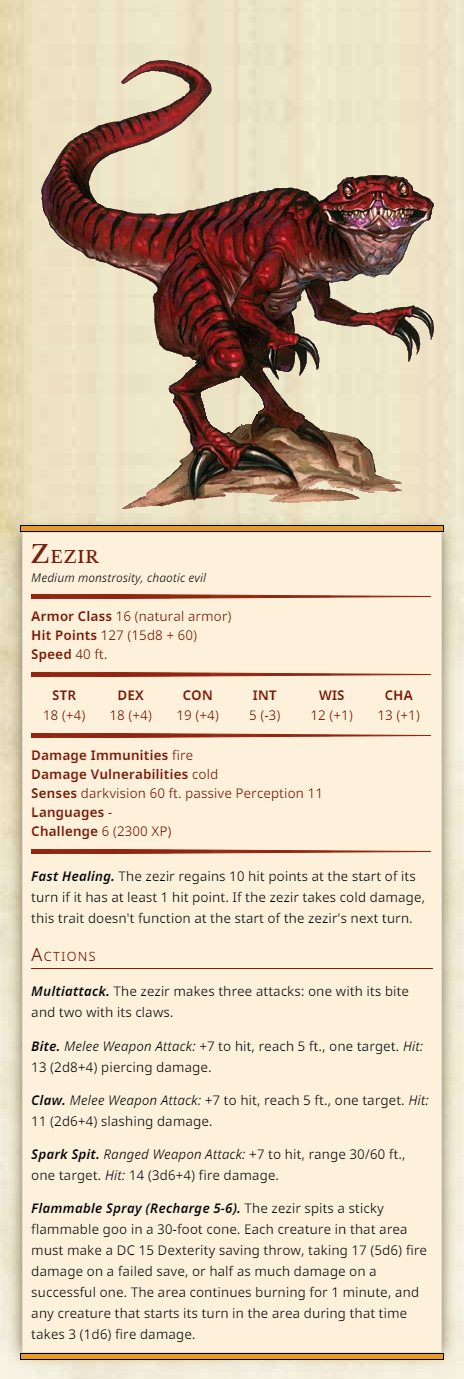
Zezir Medium monstrosity, chaotic evil Armor Class 16 (natural armor) Hit Points 127 (15d8 + 60) Speed 40 ft. Str 18, Dex 18, Con 19, Int 5, Wis 12, Cha 13 Damage Immunities fire Damage Vulnerabilities cold Senses darkvision 60 ft. passive Perception 11 Languages - Challenge 6 (2300 XP) Fast Healing. The zezir regains 10 hit points at the start of its turn if it has at least 1 hit point. If the zezir takes cold damage, this trait doesn't function at the start of the zezir's next turn. Actions Multiattack. The zezir makes three attacks: one with its bite and two with its claws. Bite. Melee Weapon Attack: +7 to hit, reach 5 ft., one target. Hit: 13 (2d8+4) piercing damage. Claw. Melee Weapon Attack: +7 to hit, reach 5 ft., one target. Hit: 11 (2d6+4) slashing damage. Spark Spit. Ranged Weapon Attack: +7 to hit, range 30/60 ft., one target. Hit: 14 (3d6+4) fire damage. Flammable Spray (Recharge 5-6). The zezir spits a sticky flammable goo in a 30-foot cone. Each creature in that area must make a DC 15 Dexterity saving throw, taking 17 (5d6) fire damage on a failed save, or half as much damage on a successful one. The area continues burning for 1 minute, and any creature that starts its turn in the area during that time takes 3 (1d6) fire damage.
The zezir is a creature of the desert, hunting alone or in packs of three to eight. They delight in fire, and often will attack caravans just for the joy of watching them burn. They are pyromaniacs to the core, and the fact that they prefer to feed on ash, and seem to gain sustenance from it, only adds to their obsession. Zezirs communicate in yips and growls. They appear reptilian, but actually are closer to being avian. They stand 5 to 5-1/2 feet tall and weigh around 150 pounds.
Originally from the Monster Manual III. A request from androidmk1.
#d&d monster#dungeons and dragons#d&d#dnd 5e#d&d homebrew#dnd#d&d 3.5#d&d 5e#dnd 3.5#thirdtofifth monstrosity#thirdtofifth cr 6
53 notes
·
View notes
Text


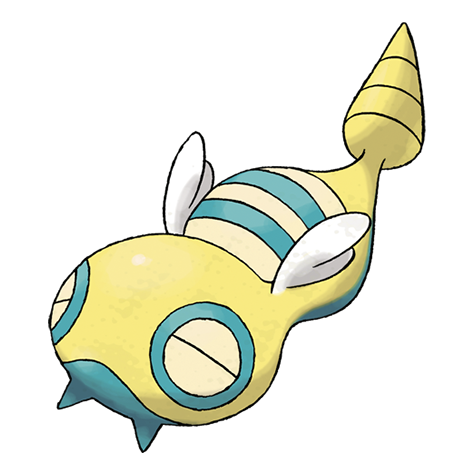
DnD 5e stat block of Pokémon: Dunsparce and Dudunsparce
#dnd#d&d#dungeons and dragons#rpg#ttrpg#5e#dnd5e#homebrew#stat block#pokemon#dunsparce#dudunsparce#monstrosity
24 notes
·
View notes
Text
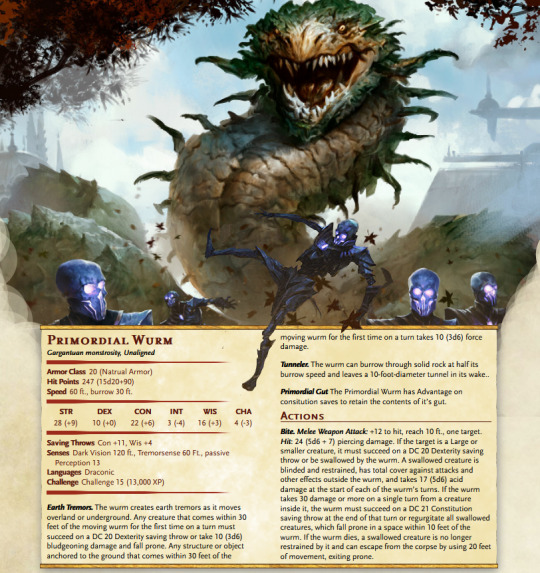
Join the Ravnica Cards Converted Discord and come hang out here https://discord.gg/PydYEEY
~~~~~~~~~~~~~~~~~~~~~~~~~~~~~~~~~~~~~~~~~~~~~~~~~~~~~~~~~~~~
To contact me directly for commision info please contact me her on tumblr.
~~~~~~~~~~~~~~~~~~~~~~~~~~~~~~~~~~~~~~~~~~~~~~~~~~~~~~~~~~~~
#d&d#dnd#d&d5e#dnd5e#d&d 5e#d&d 5e homebrew#dnd 5e#mtg to dnd#mtg to d&d#d&d creature#dnd creature#cr 15#monstrosity#war of the spark
22 notes
·
View notes
Text
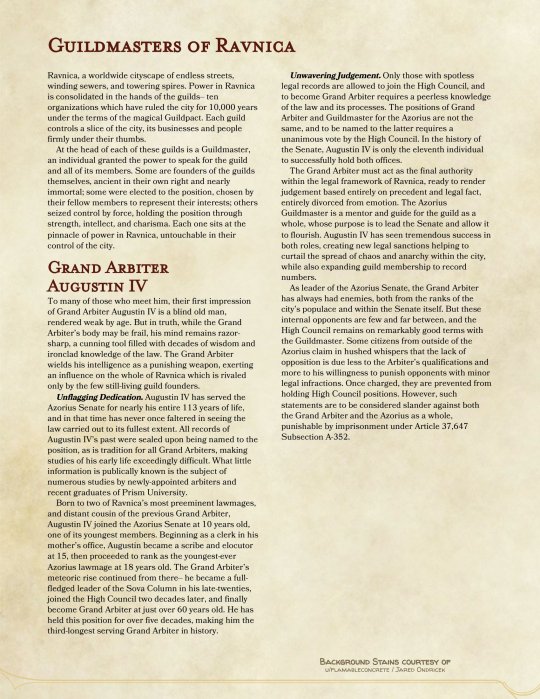

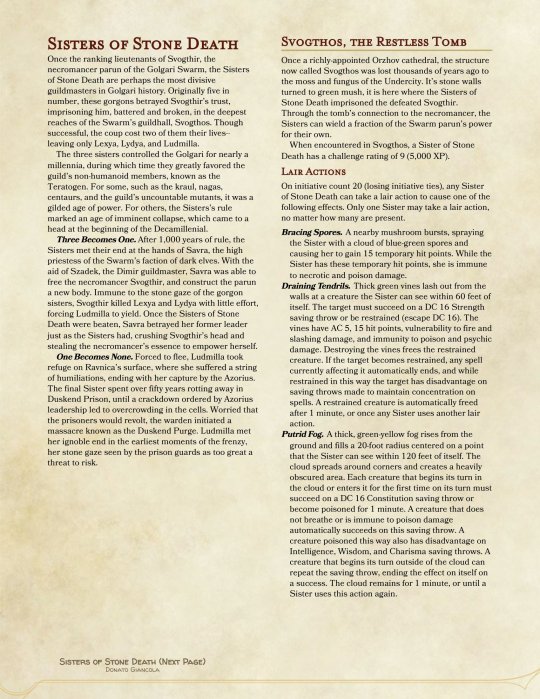
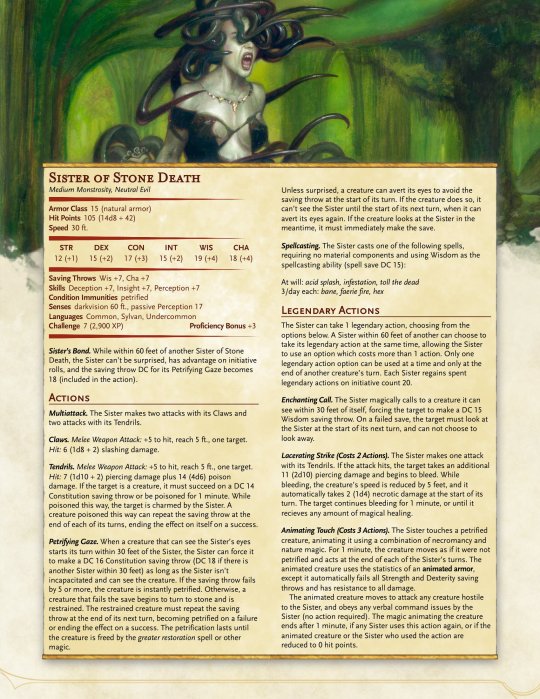
Guildmasters of Ravnica, Pt. 1
This is just a preview of five, brand-new high CR encounters for D&D 5e. Based on legendary creatures from MtG's Ravnica: City of Guilds.
If you'd like to see all five, as well as support my work and get access to other releases, you can do so over on my Patreon! Be quick though, because this release will only be public until next month.
#dnd#dnd 5e#mtg#dnd homebrew#5e homebrew#ravnica#guildmasters of ravnica#monster#cr 10#humanoid#human#cr 7#monstrosity
82 notes
·
View notes
Text

Owlbear
#dnd#dungeons and dragons#d&d#5e#owlbear#monster manual#i mean they are considered monstrosities#not beasts#so the weirder the better
8 notes
·
View notes
Text
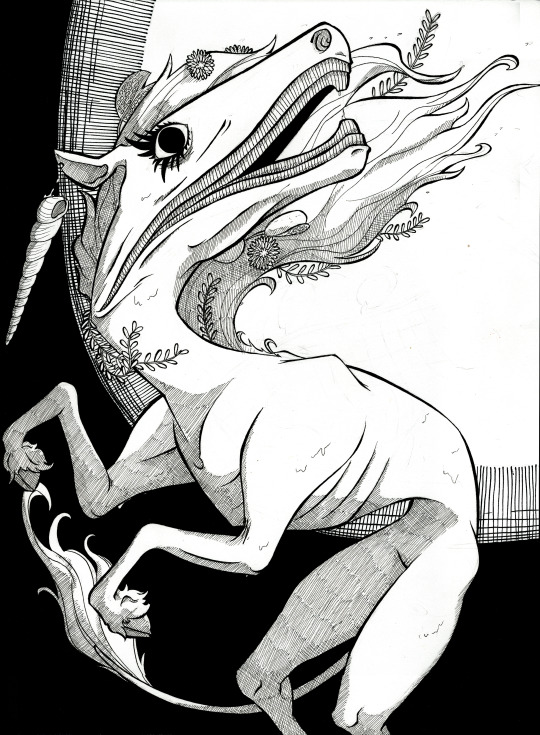
Kelpi encounter I homebrewed in for Wild Beyond the Witchlight. Good campaign but not enough combat me thinks.
#Dnd#Kelpi#Wild Beyond the Witchlight#Monstrosity#F DnD 5e's vanilla Kelpi#It's lame#So I made my own#Tried to make it look like Amalthea#and also something out of a Masaaki Nakayama book
25 notes
·
View notes
Text
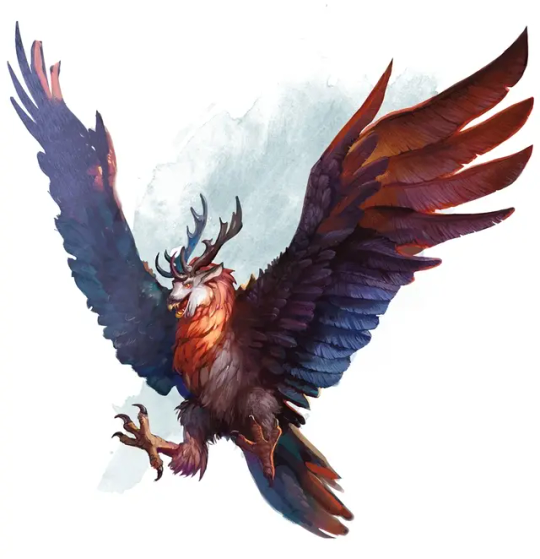
Perytons were twisted and depraved magical creatures that appeared to be a cross between a giant eagle and a demonic-looking, fang-toothed stag. They were known and feared for tearing the beating hearts from their victims' chests.
A peryton's feathered and winged body was about 7 feet (2 meters) long and 5 feet (1.5 meters) tall and was similar to that of a giant eagle with dark green or gray-green feathers. Its head, however, was covered in blue-black or purple hair and was roughly the shape of a deer's. Its maw was full of jagged fangs, and its talons were as sharp as razors. On the top of its head was a set of extremely sharp and strong antlers, which were as hard as steel and jet black in color. A male had light blue chest feathers, while a female's were pale brown. A peryton's eyes glowed or glittered and were an orange-red color.
Whatever fell magic created perytons granted them a deceptively strong hide that was nearly impervious to anything but magical weapons.
Perytons reportedly smelled like humans, although others said the smell was indescribable and immediately triggered a sense of dread.
Perhaps the strangest feature of a peryton was its shadow. The shadow did not usually resemble the shape of the beast; instead, it was said to appear as the outline of whatever creature whose heart the peryton last ate, usually an adult human. Other reports suggested that the peryton's shadow was always that of a human, and a legend told that they had once been humans themselves, hence the human shadow. There was some controversy as to when and what shadow would be cast by a peryton. Some argued that the only time a peryton cast its own shadow was immediately after killing a victim but before consuming it. Others said that a peryton's shadow reverted to its own only after eating a heart and for a brief period afterwards. Some attributed this phenomenon specifically to the female. In any case, the matter of the peryton's shadow was a longstanding mystery by the 14th century.
Unlike the eagles they resembled, perytons did not glide at high altitudes. They preferred darting close to the ground. There were conflicting tales about their maneuverability on the wing. Some claimed that they were poor fliers, while others reported that they were so maneuverable as to be able to turn at a right angle at full speed over a distance of only two hundred yards.
Perytons were as intelligent as humans. They were said to have foul tempers, but could be intelligent, patient, and cunning. Perytons would make detailed plans for a hunt, then carry them out meticulously. They would wait any length of time to achieve their aims, and though they might appear relaxed, they were ready for their prey.
They could understand at least Common and sometimes other languages, but they could not speak, at least not in words recognizable to most. Some believed that they had a language of their own, which was described as a series of pained or enraged screeches and roars, even human-like screams. By the 14th century, none had bothered, nor taken the risk, to decipher it.
They were perpetually unhappy creatures and despised their own existence, yet they were driven by a desire to kill others and someday ascend to a higher form of existence by the eating of a "perfect heart". The perytons believed that the perfect heart must always be eaten fresh, which was why they tried to tear it from living prey with their sharp talons. So strong was this desire that more intelligent perytons even kept and bred other creatures to harvest their hearts. Human hearts were the preferred variety. Strangely, perytons did not believe that an elf could have a perfect heart; they would never eat the heart of an elf, but they might still kill an elf for other reasons—or for no reason at all. Despite this, some believed that a peryton would in fact eat an elf heart, or keep them as food.
Malar the Beastlord would sometimes send perytons to aid his followers or attack their enemies.
Perytons attacked by slashing with their horns, snapping with their ferocious jaws, or clawing with their deadly talons. They were adept at attacking with all three at once. They were especially dangerous when making swooping attacks.
Ruthless, they tended to focus on attacking weakest foes first, making surprise flyby attacks from behind cover, and then darting off again. If drawn into melee combat, they hopped about on the ground, using their wings to stay about 5 feet (1.5 meters) off the ground. Stronger perytons would sometimes carry smaller prey and drop them from great heights. Whichever target was chosen, a peryton rarely changed to a new one until either the target or peryton were killed.
Whenever an opponent was helpless or unconscious—whether from crippling, paralysis, etc.—a peryton would attempt to rip the heart from the victim with its claws. It would immediately consume the organ.
Perytons sometimes hunted in groups, but their chaotic natures made it difficult for them to cooperate. They often fought over prey, since they feared that someone else might have the chance to eat the perfect heart.
They usually nested in small groups of between two to eight perytons or family groups of up to four. Nests were usually made several miles from their nearest neighbor. They were very careful about where they made their nests, choosing locales where they could avoid other winged creatures; even if they weren't a threat to them, the perytons didn't want the competition or interference. They sought an easy, clear path to their hunting grounds.
Peryton females laid eggs with shells as hard as metal. It was said that acid was required to melt through the shells. Some scholars believed that the reason perytons consumed hearts was because of the high iron content of that organ, which was thought to be used in both the perytons' antlers and eggs and perhaps their skin and feathers. In any case, a female peryton was not fertile unless she had eaten a fresh heart. This heart had to come from a humanoid—human for preference, but dwarf, elf, ogre, and orc hearts would do, though some thought it specifically had to be human. She would only remain fertile for an extremely short time—between three and eighteen hours, during which time her shadow matched her form. She would then lay between one and four eggs at a time. A mated pair of perytons shared the duties of guarding their nest and sitting on the eggs.
A peryton egg had an incubation period of up to a month. A hatchling had to be fed for the first month of life, then grew to maturity in only three months. The parent perytons often carried live prey to their nests, and watched as the infants killed and consumed them themselves. The young stayed with their parents for as long as a year, after which they left to establish their own nests.
Perytons were omnivorous and, apart from their need to eat hearts to reproduce, they could sustain themselves on vegetation. A typical meal might be rabbit, deer, or horse, but they much preferred humanoid flesh, particularly that of a human, for the sake of eating their hearts. If they were successful in tearing out and devouring a victim's heart, the flesh of the corpse served as a meal.
Perytons faced few natural predators, but one notable exception was griffons, which were powerful enough to hunt them.
Peryton females laid eggs with shells as hard as metal. It was said that acid was required to melt through the shells. Some scholars believed that the reason perytons consumed hearts was because of the high iron content of that organ, which was thought to be used in both the perytons' antlers and eggs and perhaps their skin and feathers. In any case, a female peryton was not fertile unless she had eaten a fresh heart. This heart had to come from a humanoid—human for preference, but dwarf, elf, ogre, and orc hearts would do, though some thought it specifically had to be human. She would only remain fertile for an extremely short time—between three and eighteen hours, during which time her shadow matched her form. She would then lay between one and four eggs at a time. A mated pair of perytons shared the duties of guarding their nest and sitting on the eggs.
A peryton egg had an incubation period of up to a month. A hatchling had to be fed for the first month of life, then grew to maturity in only three months. The parent perytons often carried live prey to their nests, and watched as the infants killed and consumed them themselves. The young stayed with their parents for as long as a year, after which they left to establish their own nests.
Perytons were omnivorous and, apart from their need to eat hearts to reproduce, they could sustain themselves on vegetation. A typical meal might be rabbit, deer, or horse, but they much preferred humanoid flesh, particularly that of a human, for the sake of eating their hearts. If they were successful in tearing out and devouring a victim's heart, the flesh of the corpse served as a meal.
Perytons faced few natural predators, but one notable exception was griffons, which were powerful enough to hunt them.
Perytons preferred living in temperate climates, in forests, mountains, and hills, but they could survive in colder environments as well. Large populations were known to exist in the Spine of the World; the Neth Stand forest; the Nether Mountains; the Giant's Run Mountains, where they roosted in old giant-sized palaces; the Starspire Mountains, the Walls of Halruaa; the Lonely Moor, a part of the High Moor; in the Goblin Marches and the Stonelands; the northern Thunder Peaks; the west Galena Mountains, from which they ranged across Thar; and the mountains of Turmish.
In the Stonelands and southern Goblin Marches, perytons were an incessant threat to goblins, orcs, and the other tribes that dwelled there. Very few goblinkin and orcs possessed magical weapons that could pierce their tough hides, giving them little defense against peryton attacks. From there, they often swooped upon caravans passing through Tilver's Gap; sometimes, a single large caravan would be harassed several times by perytons of different nests. Travelling east of Arabel got to be so hazardous in the 1360s DR that groups in Cormyr pushed for an mounted aerial division of the Purple Dragons to combat them. The careful perytons themselves nested over Tilver's Gap to avoid competition with griffons elsewhere in the Storm Horns and to avoid the defenses at Castle Crag.
Clearly magical beasts, perytons were widely viewed as having had a magical or otherwise unnatural creation. No one knew for sure how they'd come to be, but there many theories had been put forward. Many scholars pointed to the facts that a peryton had the scent and shadow of a human and required a human heart to reproduce, and concluded that they had once been human, perhaps cursed or magically transformed millennia before. Perytons were generally said to be the creation of one of the evil deities, but which one is forgotten. It was known that the Beast Lord of the ruins of Dekanter propagated perytons, but whether he first created them or only bred them was not clear.
An alternative and perhaps more sinister tale was put to paper by Brother Delf of Verdusk, apparently relating an ancient legend. He told that perytons had once been the Khala of Imaskar, a human race of evil Bane-worshipers. As punishment for their crimes, they were cursed by five gods of law. Lathander, god of the dawn, said "You have been swift as an eagle in your flight from justice, so I curse you each of you with the body of the eagle." Mystra, goddess of magic, said "Fierce as a wolf have you been in your persecution of the innocent, so I curse you with the teeth of the wolf." Torm, god of duty, said "Foolish as a stag in rut have you been as you shunned what is true and good, so I curse you all to bear the head and horns of the stag." Ilmater, god of suffering, said "You have tormented and torn heart and soul from your victims, so I curse you with unnatural appetites, so that you may only live and prosper after devouring the hearts of your prey." Finally, Mielikki, goddess of the forest, said "While you acted as beasts, your heart contained evil which only humans can know. I curse you to always cast the shadow of the humans you once were, to always remind you of your terrible deeds and of the souls that you have lost." Thus, they became the perytons. This tale was unsupported by fact, but it did explain all their unusual human traits. However, some, like Talyssa Strongbow, considered it ironic that their curses, particularly that of Ilmater—who aimed to shield folk from suffering—only drove the peryton to further murder and savagery. This cast doubt on the tale, or on the wisdom of the gods.
In the Year of the Groaning Cart, 1267 DR, perytons, along with harpies and manticores, destroyed the city of Lis in the Moonsea region in what was known as the Flying Plague.
Sometime around 1372 DR, King Obould Many-Arrows made an arrangement with the perytons living in the Spine of the World to defend his eastern border. In exchange, he granted them prisoners for heart-harvesting. This allowed him to focus his attentions on the Silver Marches.
Around 1374 DR, they were being stabled by the Zhentarim as mounts within the Temple in the Sky.
Sometime following the Spellplague, while exploring the Savage Frontier for his new tome Volo's Guide to Monsters the famed Volothamp Geddarm was attacked by a peryton on a crag overlooking Phandalin and lost his left eyebrow in the process.
A disturbing rumor circulating in Tilverton in the mid–14th century told that a lowland nest of perytons in the Stonelands kept captive humans, elves, orcs, and ogres. As the story went, they tended to and even cared for them, as a farmer would their cattle, because they slaughtered these poor folk for their hearts and for food for the whole nest. Some they kept alive for breeding, to replenish their stock.
Source: https://forgottenrealms.fandom.com/wiki/Peryton
4 notes
·
View notes
Text

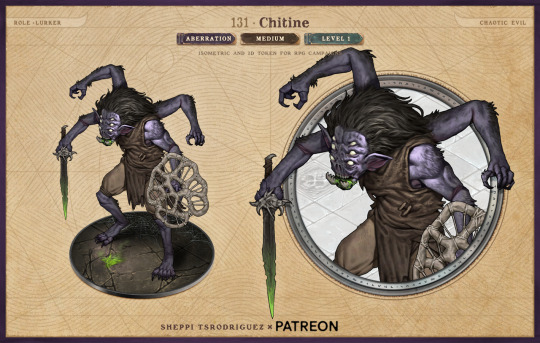
⚔️ Chitine on Patreon
-
🌟 Get access to more than 200 creatures, maps and assets by supporting us on Patreon! Complement your campaigns with hi-res monster tokens and start building the adventure of your dreams with our isometric and 2D assets 🏰!
#art#digital art#dnd#pathfinder#foundryvtt#roll20#dungeons & dragons#dnd creature#illustration#pathfinder monster#fantasy monster#aberration#monstrosity#level 1#chaotic evil#underdark#dnd 5e
9 notes
·
View notes
Text
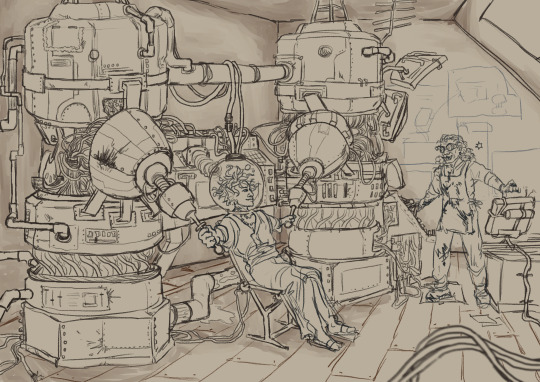
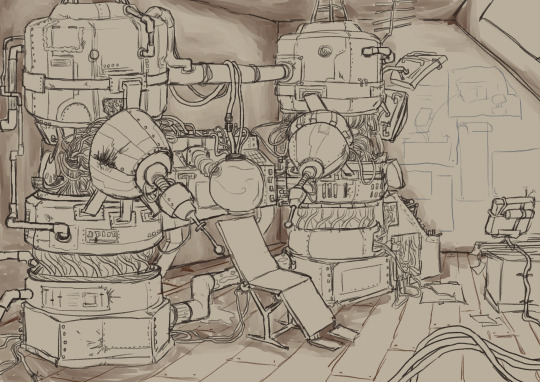
mission: run lightning through aatoi to try and speak to aliens was a SUCCESS, SOMEHOW
#(nerve got two crits on constructing this monstrosity)#aatoi#nerve#praiders#don't pay any mind to the dogshit perspective this thing has got going on#planet raiders#that's not the point of this. the point is cool machines#joe: how does aatoi interface with the machine? me: puts his head in a plasma globe. obviously.#dnd#dungeons and dragons#dnd 5e#somehow lol#would you believe me if i said nerve's class is technically now fighter#(cause he sure ain't a lover! not anymore! badumtss) (i am boo'd off the stage)
10 notes
·
View notes
Text
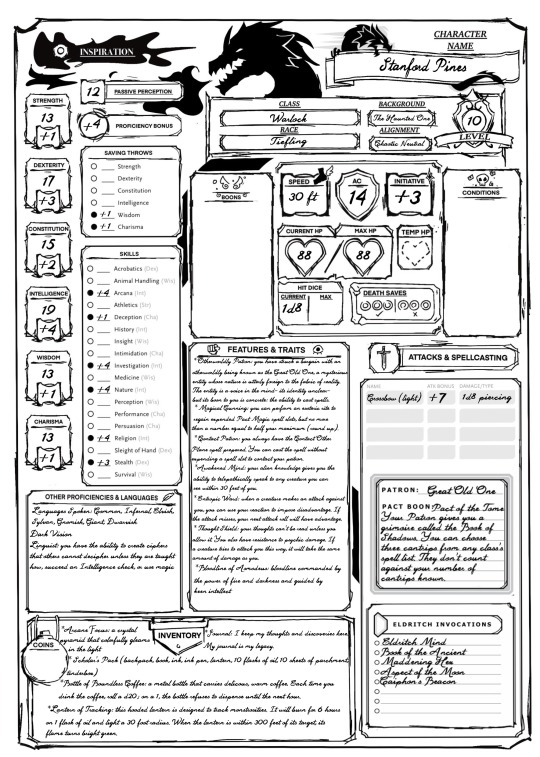

DnD 5e Character Sheet for Stanford Pines
You know, in case you ever wanted to play the most mid Warlock whose only magical items are a boundless coffee thermas and a fancy lantern.
Under the cut is the transcript of all the text as well as a descriptor for what each spell does.
I don't have any particular verbal commands but when a spell requires a Somatic omponent, Ford needs both hands to make a triangle shape with his fingers
Character Name: Stanford Pines
Class: Warlock Race: Tiefling Background: The Haunted One Alignment: Chaotic Neutral Level: 10
Passive Perception: 12 Proficiency Bonus: +4
Speed: 30 ft AC: 14 Initiative: +3
Current HP: 88/88 Hit Dice: d8
Strength: 13 (+1) Intelligence: 19 (+4) Dexterity: 17 (+3) Wisdom: 13 (+1) Constitution: 15 (+2) Charisma: 13 (+1)
Saving Throws: +1 Wisdom, +1 Charisma
Skills: Arcana (+4), Deception (+1), Investigation (+4), Nature (+4), Religion (+4), Stealth (+3)
Other Profiencies and Languages
Languages Spoken: Common, Infernal, Elvish, Sylvan, Gnomish, Giant, Dwarvish Linguist: you have the ability to create ciphers that others cannot decipher unless they are taught how, succeed an Intelligence check, or use magic Dark Vision: you can see in dim light within 60 feet of you as if it were bright light, and in darkness as if it were dim light
Features and Traits
*Otherworldly Patron: you have struck a bargain with an otherworldly being known as the Great Old One, a mysterious entity whose nature is utterly foreign to the fabric of reality. The entity is a voice in the mind- its identity unclean but its boon to you is concrete: the ability to cast spells *Magical Cunning: you can perform an esoteric rite to regain expended Pact Magic spell slots, but no more than a number equal to half your maximum (round up). *Contact Patron: you always have the Contact Other Place spell prepared. You can cast the spell without spending a spell slot to contact your patron *Awakened Mind: your alien knowledge gives you the ability to telepathically speak to any creature you can see within 30 feet of you *Entropic Ward: when a creature makes an attack against you, you can use your reaction to impose disadvantage. If a creature tries to attack you this way, it will take the same amount of damage as you *Bloodline of Asmodeus: bloodline commanded by the power of fire and darkness and guided by keen intellect
Inventory
*Arcana Focus: a crystal pyramid that colorfully gleams in the light *Journal: I keep my thoughts and discoveries here. My journal is my legacy. *Scholar's Pack: backpack, book, ink, ink pen, lantern, 10 flasks of oil, 10 sheets of parchment, and a tinderbox *Bottle of Boundless Coffee: a metal bottle that carries delicious, warm coffee. Each time you drink the coffee, roll a d20; on a 1, the bottle refuses to dispense until the next hour *Lantern of Tracking: this hooded lantern is designed to track monstrosities. It will burn for 6 hours on 1 flask of oil and light a 30 foot radius. When the lantern is within 300 feet of its target, its flame turns bright green
Attacks and Spellcasting:
Name: Crossbow (light) Attack Bonus: +7 Damage/ Type: 1d8, piercing
Patron: The Great Old One
Pact Boon: Pact of the Tome: your Patron gives you a grimoire called the Book of Shadows. You can choose three cantrips from any class's spell list. They don't count against your number of cantrips known.
Eldritch Invocations
*Eldritch Mind: you have advantage on Constitution saving throws that you make to maintain your concentration on a spell. *Book of the Ancient: you can now inscribe magical rituals in your Book of Shadows. Choose two 1st-level spells that have the ritual tag from any class's spell list. The spells appear in the book and don't count against the number of spells you know. *Maddening Hex: as a bonus action, you cause a psychic disturbance around the target cursed by your Hex spell. When you do so, you deal psychic damage to the cursed target and each creature of your choice within 5 feet of it. The psychic damage equals your Charisma modifier. *Aspect of the Moon: you no longer need to sleep and can't be forced to sleep by any means. To gain the benefits of a long rest, you can spend all 8 hours doing light activity, such as reading your Book of Shadows and keeping watch. *Caiphon's Beacon: the purple star Caiphon is the doom of inexperienced mariners. Those who use its deceptive light to guide their travels invariably come to ruin. You gain proficiency in the Deception and Stealth skills, and you have advantage on attack rolls against charmed creatures.
Cantrips
*Eldritch Blast: Range: 120 ft Save/ Attack: 2d10 Time: 1 action Concentration: No Duration: Instantaneous Components: Verbal, Somatic
A beam of crackling energy streaks toward a creature within range.
*Mind Sliver: Range: 60 ft Save/ Attack: Intelligence/ 2d6 Time: 1 action Concentration: No Duration: 1 round Components: Verbal
You drive a disorienting spike of psychic energy into the mind of one creature you can see within range.
*Minor Illusion: Range: 30 ft Save/ Attack: Intelligence Time: 1 action Concentration: No Duration: 1 minute Components: Somatic, Material
You create a sound or an image of an object within range that lasts for the duration.
*Mage Hand: Range: 30 ft Save/ Attack: None Time: 1 action Concentration: No Duration: 1 minute Components: Verbal, Somatic
A spectral, floating hand appears at a point you choose within range. You can use your action to control the hand. You can use the hand to manipulate an object, open an unlocked door or container, stow or retrieve an item from an open container, or pour the contents out of a vial.
*Fire Bolt: Range: 120 ft Save/ Attack: 2d10 Time: 1 action Concentration: No Duration: Instantaneous Components: Verbal, Somatic
You hurl a mote of fire at a creature or object within range. A flammable object hit by this spell ignites if it isn’t being worn or carried.
*Prestidigitation: Range: 10 ft Save/ Attack: None Time: 1 action Concentration: No Duration: Up to 1 hour Components: Verbal, Somatic
This spell is a minor magical trick that novice spellcasters use for practice.
*Vicious Mockery: Range: 60 ft Save/ Attack: 2d4 Time: 1 action Concentration: No Duration: Instantaneous Components: Verbal
You unleash a string of insults laced with subtle enchantments at a creature you can see within range.
1st Level
*Dissonant Whispers: Range: 60 ft Save/ Attack: Wisdom/ 3d6 Time: 1 action Concentration: No Duration: Instantaneous Components: Verbal
You whisper a discordant melody that only one creature of your choice within range can hear, wracking it with terrible pain.
*Hex: Range: 90 ft Save/ Attack: 1d6 necrotic Time: 1 bonus action Concentration: Yes Duration: 1 hour Components: Verbal, Somatic, Material
You place a curse on a creature that you can see within range. Until the spell ends, you deal an extra 1d6 necrotic damage to the target whenever you hit it with an attack. Also, choose one ability when you cast the spell. The target has disadvantage on ability checks made with the chosen ability.
*Tasha's Hideous Laughter: Range: 30 ft Save/ Attack: Wisdom Time: 1 action Concentration: Yes Duration: 1 minute Components: Verbal, Somatic, Material
A creature of your choice that you can see within range perceives everything as hilariously funny and falls into fits of laughter if this spell affects it.
*Illusory Script: Range: Touch Save/ Attack: None Time: 1 minute Concentration: No Duration: 10 days Components: Somatic, Material
You write on parchment, paper, or some other suitable writing material and imbue it with a potent illusion that lasts for the duration. To you and any creatures you designate when you cast the spell, the writing appears normal, written in your hand, and conveys whatever meaning you intended when you wrote the text. To all others, the writing appears as if it were written in an unknown or magical script that is unintelligible.
*Identify: Range: Touch Save/ Attack: None Time: 1 minute Concentration: No Duration: Instantaneous Components: Verbal, Somatic, Material
You choose one object that you must touch throughout the casting of the spell. If it is a magic item or some other magic-imbued object, you learn its properties and how to use them, whether it requires attunement to use, and how many charges it has, if any. You learn whether any spells are affecting the item and what they are.
2nd Level
*Phantasmal Force: Range: 60 ft Save/ Attack: Intelligence/ 1d6 Time: 1 action Concentration: Yes Duration: 1 minute Components: Verbal, Somatic, Material
You craft an illusion that takes root in the mind of a creature that you can see within range. While a target is affected by the spell, the target treats the phantasm as if it were real. The target rationalizes any illogical outcomes from interacting with the phantasm.
*Darkness: Range: 60 ft Save/ Attack: None Time: 1 action Concentration: Yes Duration: 10 minutes Components: Verbal, Material
Magical darkness spreads from a point you choose within range to fill a 15-foot radius sphere for the duration. The darkness spreads around corners. A creature with darkvision can’t see through this darkness, and nonmagical light can’t illuminate it.
3rd Level
*Enemies Abound: Range: 120 ft Save/ Attack: Intelligence Time: 1 action Concentration: Yes Duration: 1 minute Components: Verbal, Somatic
You reach into the mind of one creature you can see and force it to make an Intelligence saving throw. On a failed save, the target loses the ability to distinguish friend from foe, regarding all creatures it can see as enemies until the spell ends. Each time the target takes damage, it can repeat the saving throw, ending the effect on itself on a success.
*Clairvoyance: Range: 1 mile Save/ Attack: None Time: 10 minutes Concentration: Yes Duration: 10 minutes Components: Verbal, Somatic, Material
You create an invisible sensor within range in a location familiar to you (a place you have visited or seen before) or in an obvious location that is unfamiliar to you (such as behind a door, around a corner, or in a grove of trees). The sensor remains in place for the duration, and it can’t be attacked or otherwise interacted with. When you cast the spell, you choose seeing or hearing. You can use the chosen sense through the sensor as if you were in its space.
4th Level
*Evard's Black Tentacles: Range: 90 ft Save/ Attack: Dexterity/ 3d6 Time: 1 action Concentration: Yes Duration: 1 minute Compoents: Verbal, Somatic, Material
Squirming, ebony tentacles fill a 20-foot square on ground that you can see within range. For the duration, these tentacles turn the ground in the area into difficult terrain.
When a creature enters the affected area for the first time on a turn or starts its turn there, the creature must succeed on a Dexterity saving throw or take 3d6 bludgeoning damage and be restrained by the tentacles until the spell ends.
*Banishment: Range: 60 ft Save/ Attack: Charisma Time: 1 action Concentration: Yes Duration: 1 minute Components: Verbal, Somatic, Material
You attempt to send one creature that you can see within range to another place of existence.
If the target is native to the plane of existence you’re on, you banish the target to a harmless demiplane. While there, the target is incapacitated. The target remains there until the spell ends, at which point the target reappears in the space it left or in the nearest unoccupied space if that space is occupied. If the target is native to a different plane of existence that the one you’re on, the target is banished with a faint popping noise, returning to its home plane.
5th Level
*Synaptic Static: Range: 120 ft Save/ Attack: Intelligence/ 8d6 Time: 1 action Concentration: No Duration: Instantaneous Components: Verbal, Somatic
You choose a point within range and cause psychic energy to explode there. Each creature in a 20-foot-radius sphere centered on that point must make an Intelligence saving throw.
After a failed save, a target has muddled thoughts for 1 minute. During that time, it rolls a d6 and subtracts the number rolled from all its attack rolls and ability checks, as well as its Constitution saving throws to maintain concentration.
24 notes
·
View notes
Note
Thought I’d drop you an ask about your D&D character(s) after your nostalgia post. Consider it an opportunity to wax lyrical if you want
Oh man, my high school D&D characters, hell yeah.
It was the best of times, it was the worst of times...
So my high school D&D group was probably most notable for being waaaaay too big, because the guy who who was running the game that started the whole thing didn't quite know how to say no to people asking to join, and ballooned up from maybe six people to like. Thirteen. Which is fucking massive and horribly unwieldy, and bear in mind we were playing 3.5, where combat was somehow even worse and more long-lasting than modern 5e.
(This, incidentally, was how Ferro and I got to know each other properly, because of our group he was the one who didn't go to the same school as the rest of us, but he'd known the DM since they were like two. We got each other in the epic six-way post-college friend divorce, and Dan and Cedric got married.)
I can't remember any of their names, but the two characters that come to mind from that period were the very first character I made, an elf bard (natch) who came in late to the game comparatively late but had a few cool moments that mostly actually revolved around nerfing this other player's constant attempts to kill a different guy's characters, because he was that type of guy who would make a big thing out of playing chaotic evil characters to justify bullying other players. I had a couple moments in the climatic final battle of that first campaign where I mostly stopped him from ruining what everyone else was doing, lol.
The next campaign, which to this day remains an old favorite, was an Underdark exclusive where we realized that we couldn't reasonably play another game with this many people and split off into two groups. Ferro Dm'd one, and my then-girlfriend DM'd the other. I played an Orc barbarian with like 1 intelligence who made friends with the other characters and formed a bond with them. We spent a huge amount of that campaign fucking around and getting into stupid scrapes instead of following the storyline, it was fun.
I have a lot of nostalgia for that group, even though we were objectively kind of a trainwreck. We all learned a lot, certainly, and all of us went on to have a lot interest in game creation and craft later. We had a bunch of stupid in-jokes, like you do, and we would sometimes cosplay our characters for big moments.
These days I haven't had a group to play with in a few years, in part because I really don't want to play D&D or other crunch-heavy games, but it's hard to get people to branch out to other games, although given how WotC has shat the bed recently, there's been a lot more interest in other types of ttrpgs, so we'll see what the future holds.
R's group is so...they remind me of that old teen group so much. The only thing that's really changed is which edition they're playing, and the fact they're all packing smartphones rather than little flip/slider late 2000s monstrosities with a hundred phone charms hanging off them. When I walked in on them, they were, as cliched as it sounds, actually about to fight a dragon, so I watched them play for a bit. R kept beefing her rolls, and her friend was convinced that he could repair a wall they broke with the one hundred crackers he had in his inventory. One of the girls had a really expensive-looking heavy metal dice set that everyone else was envious of, because she's apparently about as veteran of a player as you can be at fifteen and collects dice sets. Of course.
It was just really fun seeing kids playing, and the whole thing continuing on to a whole new generation. There was a dad who came in looking for something else, and he told me he used to play AD&D back in the eighties when he was a teen. At this point the game's been around long enough to have multiple generations playing together, which is absolutely delightful.
13 notes
·
View notes
Text

Protean Scourge Medium monstrosity (shapechanger), neutral evil Armor Class 17 (natural armor) Hit Points 161 (19d8 + 76) Speed 40 ft., climb 10 ft. Str 20, Dex 17, Con 19, Int 14, Wis 14, Cha 19 Damage Immunities poison Damage Resistances cold, lightning; bludgeoning, piercing, and slashing from nonmagical attacks that aren't silvered Condition Immunities petrified, poisoned Senses darkvision 60 ft. passive Perception 12 Languages Abyssal, Common, Infernal Challenge 12 (8400 XP) Magic Resistance. The protean scourge has advantage on saving throws against spells and other magical effects. Shapechanger. The protean scourge can use its action to polymorph into a Small or Medium humanoid, or back into its true form. Its statistics, other than its size, are the same in each form. Any equipment it is wearing or carrying isn't transformed. It reverts to its true form if it dies. Spellcasting. The protean scourge is a 8th-level spellcaster. Its spellcasting ability is Charisma (spell save DC 16, +8 to hit with spell attacks). The protean scourge has the following sorcerer spells prepared: Cantrips (at will): dancing lights, mage hand, prestidigitation 1st level (4 slots): charm person, color spray, mage armor 2nd level (3 slots): mirror image, scorching ray, spider climb 3rd level (3 slots): blink, haste 4th level (2 slots): greater invisibility Actions Multiattack. The protean scourge makes either two attacks with its claws and one attack with its gore; or three attacks with its scythe and one attack with its gore. Claws. Melee Weapon Attack: +9 to hit, reach 5 ft., one target. Hit: 9 (1d8+5) slashing damage. Gore. Melee Weapon Attack: +9 to hit, reach 5 ft., one target. Hit: 16 (2d10+5) piercing damage. If the target is a Large or smaller creature, it must succeed on a DC 17 Strength saving throw or be knocked prone. Scythe. Melee Weapon Attack: +9 to hit, reach 5 ft., one target. Hit: 12 (2d6+5) slashing damage. Reactions Split. When the protean scourge is subjected to damage, it splits into two new protean scourges if it has at least 10 hit points. Each new protean scourge has hit points equal to half the original protean scourge's, rounded down. Each new protean scourge can cast spells, but they share a pool of spells per day as if they were one creature. The two protean scourges can recombine in a process that takes one minute and requires both protean scourges to be within 5 feet of each other. The separate protean scourges are incapacitated while recombining, and only two protean scourges who were originally separated from each other can recombine.
These deadly shapechanging assassins are often mistaken for denizens of the Abyss. With abnormally-long legs and pebbly red skin, the confusion is understandable. They love killing above all else, and seek out opportunities to do so, happily submitting to the service of evil warlords and the like to sate their bloodlust. These thoroughly-cruel creatures stand around 7 feet tall and weigh 200 pounds.
Originally from the Monster Manual III
#d&d 5e#dungeons and dragons#d&d homebrew#dnd#dnd 5e#dnd 3.5#d&d#d&d monster#thirdtofifth monstrosity#thirdtofifth CR 12
237 notes
·
View notes
Text
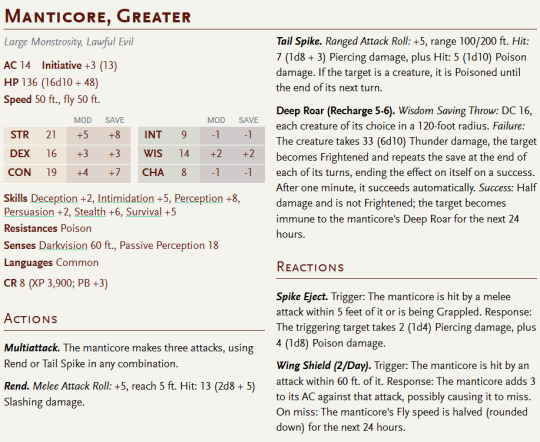

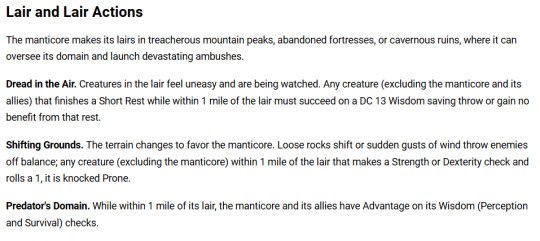
DnD stat blocks of Manticore variants
#dnd#dungeons and dragons#d&d#ttrpg#rpg#dnd5e#5e#homebrew#stat block#monster#monstrosity#manticore#mythical creatures#mythology
8 notes
·
View notes
Text
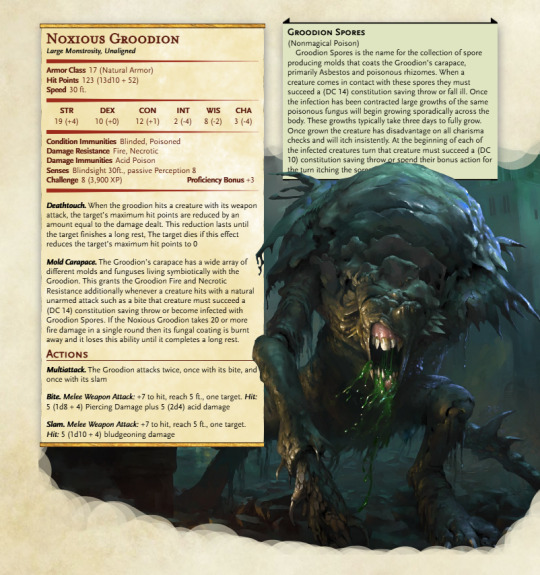
Join the Ravnica Cards Converted Discord and come hang out here https://discord.gg/PydYEEY
~~~~~~~~~~~~~~~~~~~~~~~~~~~~~~~~~~~~~~~~~~~~~~~~~~~~~~~~~~~~
To contact me directly for commission info please contact me here on tumblr.
~~~~~~~~~~~~~~~~~~~~~~~~~~~~~~~~~~~~~~~~~~~~~~~~~~~~~~~~~~~~
#d&d#dnd#d&d5e#dnd5e#d&d 5e#d&d 5e homebrew#mtg to dnd#dnd 5e#d&d creature#mtg to d&d#cr 8#monstrosity#Noxious Groodion
17 notes
·
View notes
Text

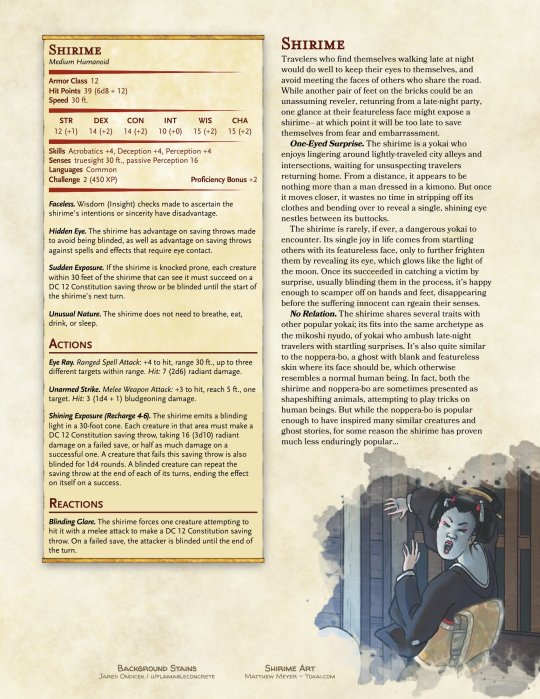
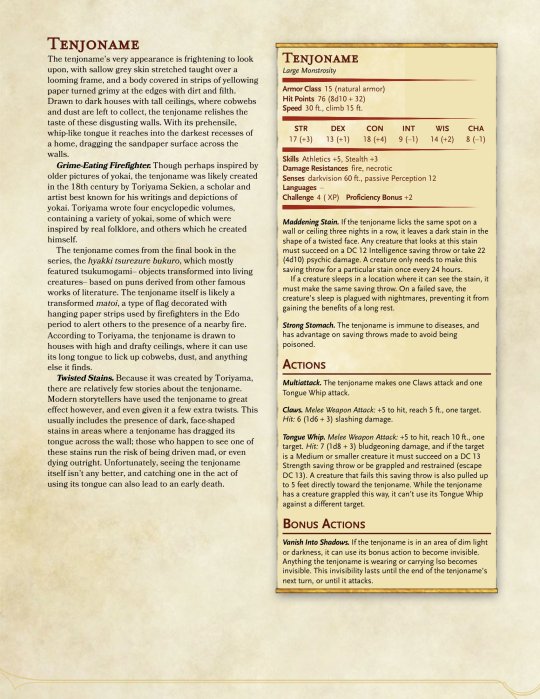
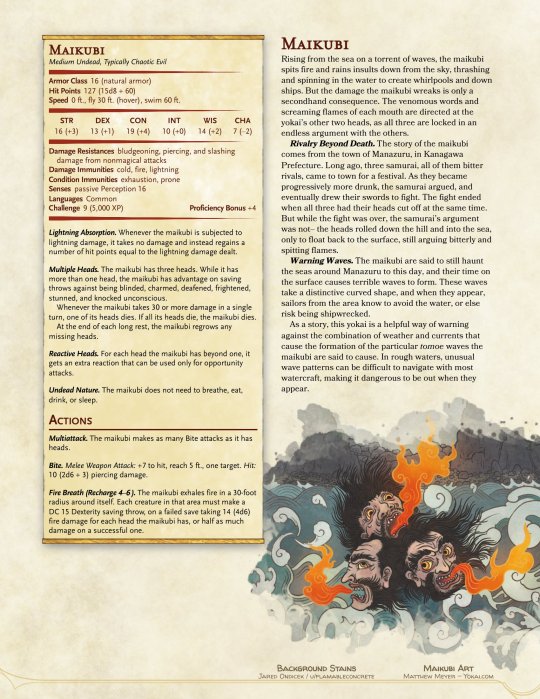
Yokaitober, Days 9-12
Helping to shorten the gap between the current date and how many yokai I've actually posted, here's Days 9-12 of my Yokaitober project. This set includes the kamakiri, a goblin cosplaying Edward Scissorhands who's obsessed with cutting hair; the shirime, a spooky faceless ghost that's desperate to flash you its eye; the tenjoname, a naked monster covered in paper strips who licks the grim off your ceilings; and the maikubi, the severed heads of three samurai who just couldn't stop fighting.
If you're unfamiliar with Japanese folklore, this assemblage of creatures probably reads like a demonic fever-dream. If you have even a passing knowledge of yokai, then you know these are really just par for the course. Okay, so maybe the shirime is pretty out there, but it's also not the strangest example of Japanese humor.
Regardless of whether you find these yokai creepy, funny, or unexplainably cute, they're all here for you to use in your own games of 5e. If you're interested in more yokai like these, as well as other 5th edition homebrew including subclasses, magic items, other monsters, and more, be sure to check out my Patreon. You can choose to support me there for as little as $2/month, or even just sign up to follow me and get alerts about when I release new stuff.
#dnd#dnd 5e#yokai#dnd homebrew#promptober#yokaitober#monster#cr 1#fiend#kamakiri#cr 2#humanoid#shirime#cr 4#monstrosity#tenjoname#cr 9#undead#maikubi
44 notes
·
View notes
Text
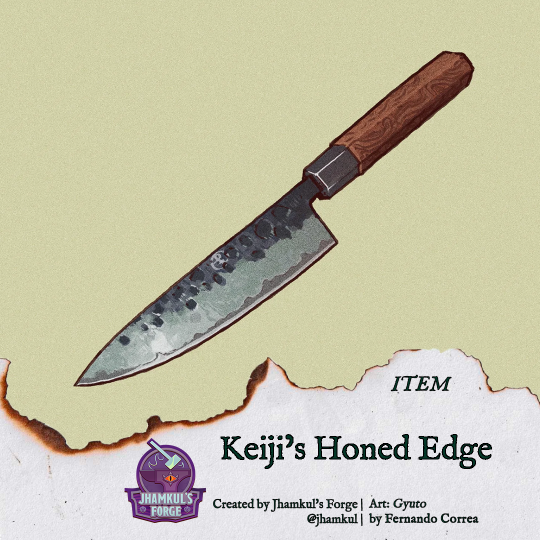
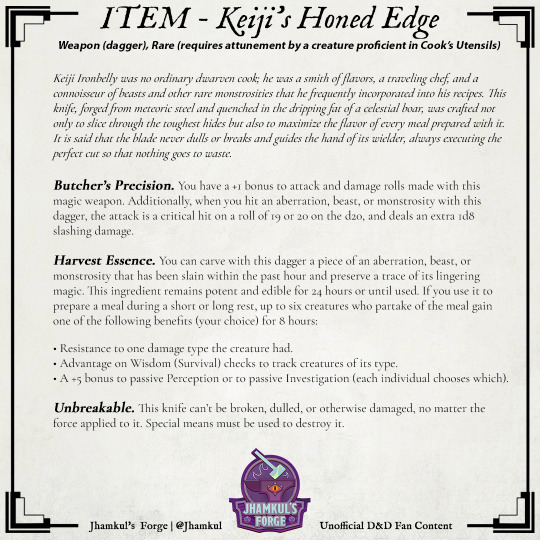
Keiji’s Honed Edge Weapon (dagger), Rare (requires attunement by a creature proficient in Cook’s Utensils)
This one's for all of you missing Dungeon Meshi/Delicious in Dungeon as much as I am right now and counting the days until season two drops. Ideal for adventurers who treat downtime like Iron Chef, or for the survivalist ranger who's part Gordon Ramsay, part Geralt of Rivia. Whether you're carving up aberrations for arcane seasoning or plating monstrosity stew between combat encounters, this magical dagger makes every dungeon dive taste better.
How might this find its way into your world?
▫️Buried in a bulette’s shell, as if the beast was half-butchered from the inside out ▫️Gifted by a retiring dwarven chef, who hangs up his apron to open a rural tavern (but only after one last hunt) ▫️Won in a cook-off judged by a very picky archfey with a taste for the extraordinary
Tell me: What’s the most questionable thing your party’s ever tried to cook mid-campaign? (No judgment. Okay, some judgment.)
—
➡️ Follow Jhamkul’s Forge on Instagram for more D&D 5e content. Help me reach 10k before the end of the year!
#jhamkul's forge#dnd#dungeons & dragons#dungeons and dragons#dnd 5e homebrew#dnd homebrew#ttrpg#dnd5e#5e homebrew#rpg#d&d#d&d 5e#d&d homebrew#d&d 5e homebrew#dungeon master#dnd dm#dungeonsanddragons#tabletop#tabletoprpg#fantasy#fantasy art#critical role#dnd community#dnd items#dnd item#dnd magic items#dungeon meshi#delicious in dungeon#senshi dungeon meshi#dagger
10 notes
·
View notes